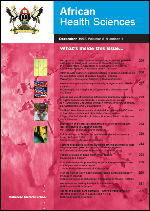
|
African Health Sciences
Makerere University Medical School
ISSN: 1680-6905
EISSN: 1680-6905
Vol. 12, No. 4, 2012, pp. 446-451
|
 Bioline Code: hs12077
Bioline Code: hs12077
Full paper language: English
Document type: Research Article
Document available free of charge
|
|
|
African Health Sciences, Vol. 12, No. 4, 2012, pp. 446-451
| en |
Prevalence and factors associated with anterior open bite in 2 to 5 year old children in Benin city, Nigeria
Ize-Iyamu, I N & Isiekwe, M C
Abstract
Background: Anterior open bite is said to exist when there is an actual vertical gap between the upper and lower incisors
with the teeth in centric occlusion. This could occur in the anterior or posterior region, and may be attributed to the supra
eruption of the posterior teeth or the infra eruption of the anterior teeth and it is common in both adults and children.
Objective: To evaluate the prevalence of anterior open bite (AOB) in 2 to 5 -year -old children and the aetiological factors
responsible for it.
Methods: The study group comprised 1031 children (429 boys and 602 girls) between the ages of 2 to 5-years, who were
examined for the presence of AOB and the relationship with various oral habits.
Results: AOB was present in 29 (2.8%) of the subjects. Sucking habits were observed in 267 (25.9%) children. Only
29(10.9%) of the children with sucking habits had an AOB which was asymmetric in 20 (7.5%) and symmetric in 9 (3.4%).
The asymmetric AOB was significantly higher in children with thumb sucking habits than in finger suckers (P<0.05). There
was no significant difference between frequency, duration of sucking habits and AOB. The 4-year olds showed a significant
difference in the number of children with AOB (P<0.05). Sucking habits of 1-2 hours and duration of 24 to 60 months
exhibited the highest prevalence of an AOB in 13 (44.8%) and 17 (58.6%)children respectively.
Conclusion: The prevalence of AOB in this study is 2.8%. Thumb sucking is the most important aetiological factor in the
formation of an AOB in 2 to 5-year-old children.
|
| |
© Copyright 2012 - African Health Sciences
|
|
